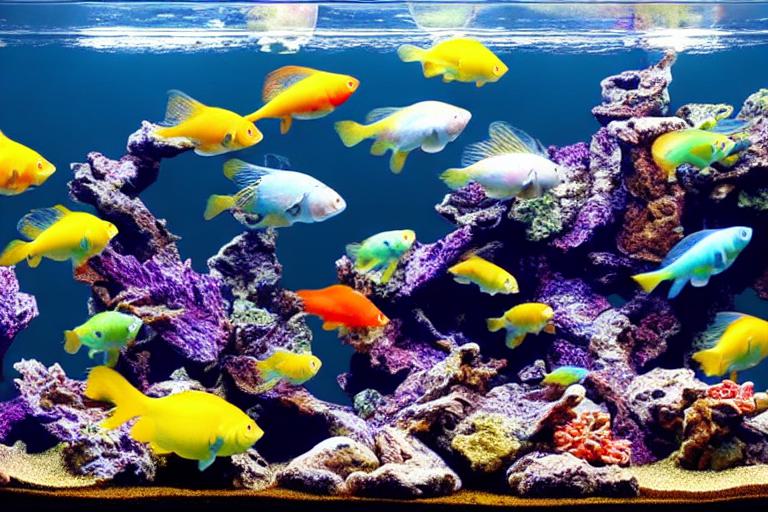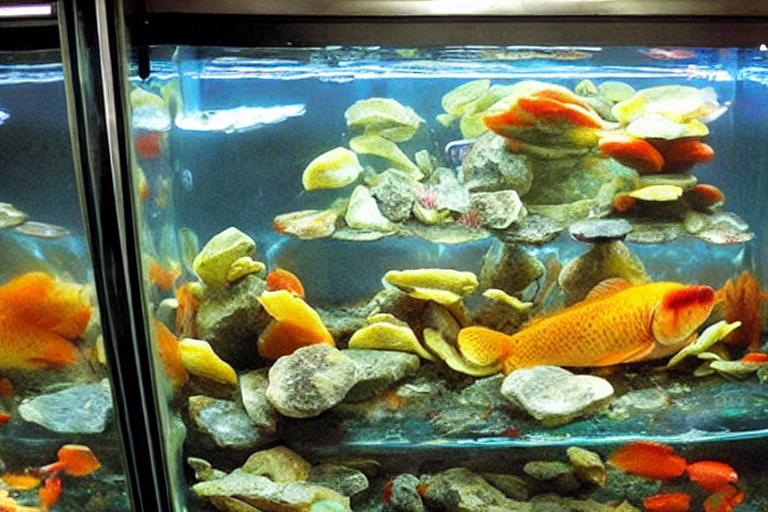Aquarium fish are a popular pet for many people, but caring for them can be a challenge. One of the most important things to consider when caring for aquarium fish is what to feed them. There are a variety of fish foods available on the market, and it can be difficult to know which one is best for your fish. This guide will provide a beginner’s overview of the different types of fish food and what to consider when choosing the right food for your aquarium fish.
What to Feed Aquarium Fish?
Aquarium fish need a diet that is high in protein and low in fat. The best way to provide these nutrients is to feed them a variety of foods. They also need a variety of vitamins and minerals.
One type of food that aquarium fish need is live food. It is also a good way to provide exercise for your fish. Live food is a good source of protein and essential nutrients. This can include brine shrimp, bloodworms, and daphnia.
Another type of food that aquarium fish need is pellets. Pellets are a processed form of fish food that is high in nutrients. They are a good option for fish that are picky eaters or that have trouble digesting live food.
Aquarium fish also need vegetables. Vegetables are a good source of vitamins and minerals. They can be fed fresh, frozen, or freeze-dried.
When choosing a food for your aquarium fish, it is important to read the label. The label will tell you what the food is made of and how much of each nutrient it contains. It is also important to choose a food that is appropriate for the fish you are feeding.

Different Types of Fish Food
Here is a beginner’s guide to choosing the right fish food for your aquarium fish. While there are many types of fish food on the market, not all of them are suitable for every fish. Aquarium fish come in a variety of shapes and sizes, and their diet needs vary as well.
Smaller fish need smaller food, so they can easily digest it. There are also fish food pellets that are specially made for different size fish. Larger fish need larger food so they can get the nutrition they need. One of the most important things to consider when choosing fish food is the size of your fish.
Another thing to consider is the type of fish you have. Choose a fish food that is suitable for the type of fish you have. Some fish are herbivores and only eat plants, while others are carnivores and only eat meat. There are also omnivorous fish that eat both plants and meat.
Finally, consider the ingredients in the fish food. Always read the labels carefully before purchasing fish food. Some fish are allergic to certain ingredients, so it’s important to choose a fish food that does not contain any ingredients that could harm your fish.
However, by considering the size of your fish, the type of fish you have, and the ingredients in the fish food, you can narrow down your choices and find the best fish food for your aquarium fish. With so many different types of fish food on the market, it can be difficult to know which one to choose.
Dry Food
Dry food is one of the most common types of food for aquarium fish. Dry food is typically high in protein and can be a good source of vitamins and minerals. It is easy to find and usually comes in a variety of formulations to meet the needs of different fish species.
This makes it a good option for fishkeepers who do not have the time or inclination to feed their fish live or frozen food on a regular basis. One advantage of dry food is that it does not spoil as quickly as wet or live food.
Another advantage of dry food is that it is less messy than wet or live food, and it does not cloud the water as much.
In addition, dry food can sink to the bottom of the aquarium, where it can be eaten by bottom-dwelling fish or become trapped in the gravel, making it difficult to clean up. Disadvantages of dry food include the fact that it is often less nutritious than wet or live food, and it can be difficult to get some fish to eat it.
Frozen Food
Aquarium fish are often thought of as delicate creatures, but in reality, they are quite hardy. This means that they can go without food for long periods of time without any ill effects. One of the reasons they are so hardy is their ability to store food in their bodies.
One of the best ways to ensure that your fish have a constant food supply is to stock up on frozen food. Frozen food is easy to store and will last for months in your freezer. When you are ready to feed your fish, simply thaw out a portion and feed it to them.
You can also find specialty foods designed for specific types of fish. Be sure to ask your local fish store for advice on what to feed your fish. There are a variety of frozen foods available for fish, including bloodworms, brine shrimp, and daphnia.

Freeze-Dried Food
One important aspect of caring for aquarium fish is providing them with the right food. Aquarium fish are often thought of as low-maintenance pets, but they still require some care and attention.
One type of food that is becoming increasingly popular for aquarium fish is freeze-dried food. Freeze-dried food is made by freeze-drying raw ingredients and then packaging them in a airtight container. This type of food has a number of advantages over other types of fish food.
Freeze-drying helps to preserve the nutrients in the food, so your fish can get all the benefits of a healthy diet. One advantage of freeze-dried food is that it is highly nutritious.
And, because it doesn’t require refrigeration, it is easy to take with you when you travel. Another advantage of freeze-dried food is that it is easy to store and transport. Freeze-dried food takes up less space than other types of fish food, so it is easy to keep on hand.
If you are looking for a nutritious and convenient option for feeding your aquarium fish, consider freeze-dried food.
Live Food
A healthy diet is essential for your fish to thrive. However, what many new fish owners don’t realize is that what you feed your fish can be just as important as keeping the water clean. Aquarium fish are often thought of as being low-maintenance pets.
Plus, many fish enjoy the challenge of chasing and catching their food. Live food is a great option for fish because it is high in protein and nutrients. One type of food that is gaining popularity among fish owners is live food. This includes foods like brine shrimp, bloodworms, and daphnia.
Be sure to only buy from a reputable source and quarantine new fish before adding them to your tank. If you’re interested in trying live food, there are a few things to keep in mind. If you’re on a budget, you can culture your own live food or look for deals at your local pet store. Secondly, live food can be expensive. First, live food can introduce diseases and parasites into your aquarium.
Whether you choose to feed your fish live food or not, the most important thing is to do your research and find a diet that is right for your fish. A healthy diet will help your fish live a long and happy life.
Green Vegetables
They are packed with vitamins, minerals, and other nutrients that are essential for fish health. Green vegetables can be fed to fish in a number of ways, including fresh, frozen, or freeze-dried. Green vegetables are an excellent source of nutrition for aquarium fish.
These nutrients can cause algae blooms in aquariums. Some good choices of green vegetables for fish include spinach, kale, and zucchini. When selecting green vegetables for your fish, it is important to choose those that are low in nitrates and phosphates.
If the fish seem to enjoy the vegetables and there are no negative consequences, such as increased algae growth, then the amount can be increased. Start by feeding a small amount once or twice a week. Green vegetables should be introduced into the diet of aquarium fish gradually.
What to Look for When Buying Fish Food in The Store?
The first is that you need to find food that is specifically designed for the type of fish that you have. When you are looking for fish food, there are a few things that you need to keep in mind. There are many different types of fish food on the market, so you need to make sure that you are getting the right kind.
You want to make sure that the food is small enough for the fish to eat, but not so small that they can’t digest it properly. Another thing to keep in mind is the size of the fish food.
This means that it should be made from fresh, quality ingredients. Finally, you want to make sure that the fish food is high in quality. Avoid fish food that is made from fillers or by-products.
Frequently Asked Questions
1. What are the different types of fish food?
There are three main types of fish food: pellets, flakes, and live food. Pellets are the most common type of fish food and come in a variety of sizes and shapes. Flakes are another popular type of fish food that are easy to use and can be found in most pet stores. Live food, such as worms or brine shrimp, is also available and is often used to feed larger fish or fish that are difficult to feed.
2. How often should I feed my fish?
Most fish should be fed once or twice a day. It is important to not overfeed your fish as this can lead to health problems. Overfeeding can also cause water quality problems, so be sure to remove any uneaten food from the tank.
3. What are some common fish foods?
There are a variety of fish foods available, but some of the most common are pellets, flakes, and live food.
4. What are the benefits of live food?
Live food is often used to feed larger fish or fish that are difficult to feed. Live food can also be a good source of nutrition for your fish.
5. Are there any risks associated with live food?
If not handled properly, live food can introduce bacteria or parasites into your aquarium. It is important to only purchase live food from a reputable source and to follow all handling instructions.
Final thoughts
Aquarium fish are not as finicky as one might think when it comes to food. In fact, most fish will eat just about anything. However, there are some things to keep in mind when choosing fish food. First, it is important to choose a food that is high in protein. Second, the food should be small enough for the fish to eat. Third, the food should be easy to digest. fourth, the food should not contain any harmful chemicals. Finally, the food should be fresh.
